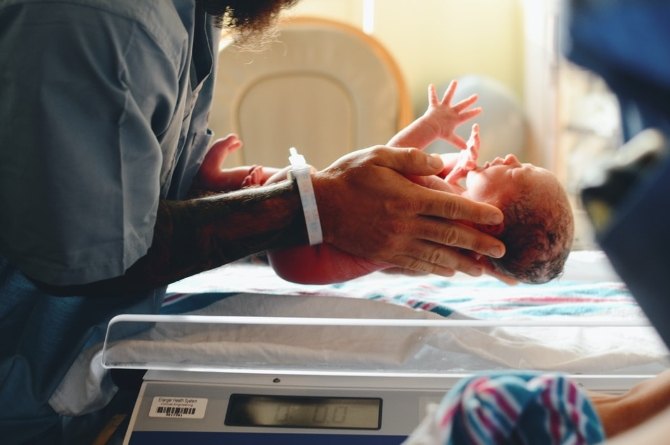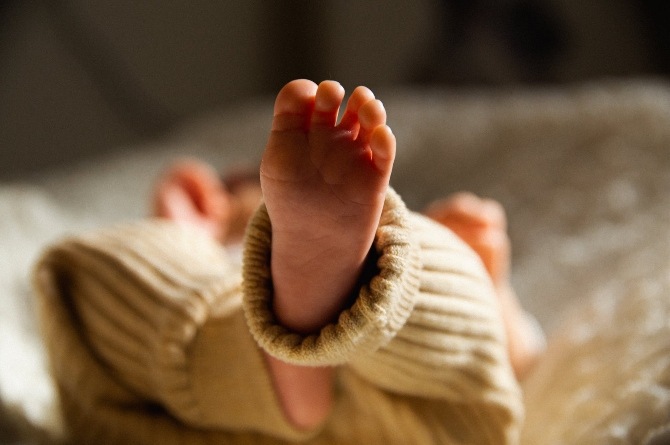Do you notice that your newborn is easily startled? Here’s what you need to know about Moro reflex or Startle reflex in babies.
In this article, you’ll read:
- My baby is always startled – is this normal?
- What is Moro reflex?
- How to help a startled baby
What could be calmer than watching a sleeping baby? Seeing a child peacefully napping can also make a parent feel relaxed. And then all of a sudden, you’ll notice him get startled with matching arms and legs up in the air. Is this normal? And why does it happen often?
Baby is easily startled
Like grown-ups, newborns also have their own instinctive reflexes or a body’s natural reaction towards something. Doctors actually take note of some of these as soon as the baby is born.
Some of the natural reflexes that we notice in newborns are the following:
- rooting
- sucking
- grasping
- stepping
One of the earliest newborn reflexes that always catch our attention is called Moro Reflex.

Larawan mula sa Unsplash
Moro Reflex
Also known as startle reflex, Moro reflex to the body’s involuntary motor response (meaning they cannot control it) that newborns do when they are startled.
This is usually described as the sudden raising or flailing of the baby’s arms and legs (sometimes even their heads) when they are startled, then they will just go back to their previous sleeping position as if nothing happened. Although sometimes, this is followed by crying.
When can you notice it?
As mentioned earlier, doctors take note of this particular reflex as soon as the baby is born. They use a certain technique called the head drop method wherein they will lower down baby’s head to see if he will react.
Parents can also notice this when the baby is in a noisy or brightly-lit room. Sudden movements around him can also trigger this response. And yes, even his own movements can cause your newborn to be startled.
Another trigger for this reflex is the sensation of falling. Your baby feels this when you try to pick him up from his crib or when you lay him down on his bed after carrying him.
Moro reflex is most prevalent in newborns until the 12th week. By the 4th month, your child will learn how to support his neck and head, which lessens the occurrence of this reflex.
As your child’s brain develops, they also learn to control their actions. So expect this reflex to lessen, as well as the baby’s startling episodes. They may later on just raise their arms, but not their legs and head.
Moro reflex usually goes away on its own when the baby reaches 6 months. If this persists, it’s best to consult your child’s paediatrician as it can be a sign of a development delay or another medical condition.
Is it normal?
As mentioned earlier, being easily startled is normal in newborns and is part of their natural reaction to their surroundings.
However, there are some newborns that display abnormal Moro reflex. For instance, when just one side of his body moves as a reaction. Some babies show no reaction at all.
The absence of this reflex could indicate a possible sign of a disorder in the brain or the spinal cord. Moreover, it can also be because of the following:
- the infant sustained an injury during birth
- infection while inside the mother’s womb or at birth
- weak muscles
- spastic cerebral palsy
- peripheral nerve damage
As we stressed earlier, having the startle reflex (in two sides of the body) is a good sign in newborns. However, there are also infants who have overactive or exaggerated Moro reflex that may also affect their sleep.
In these rare cases, exaggerated Moro reflex can be a symptom of hyperekplexia, a genetic neurological condition.
Babies with hyperekplexia have an overactive startle response, followed by stiffening of the muscles and paralysis. It also makes it difficult for infants to move their limbs.
If you notice that your child’s Moro reflex may be exaggerated, don’t hesitate to have him assessed by a paediatrician.

Larawan mula sa Pexels
Infantile spasms
Meanwhile, it can also help to understand that there’s something called infantile spasms. Also called West syndrome, this is characterized by seizures that happen to children with epilepsy. It can be mistaken as Moro reflex because of the similarity in movement.
Infantile spasms also come in different forms. Some babies bend their backs while raising their arms and legs, while some babies curl inward, their limbs stiffening. Infantile spasms usually start between 4 to 8 months, and disappear on their own by age 5.
If you can’t distinguish your child’s actions if they’re Moro reflex or infantile spasms, better consult your child’s doctor right away as they can immediately tell the difference between the two.
ALSO READ:
11 Newborn Reflexes Every New Mum Needs to Know About
Tonic Neck Reflex In Newborn Babies: What It Is and How To Test For It
Sucking reflex in babies: How it affects feeding and nutrition
How to calm a startled baby?
If you don’t notice something unusual with your baby, then you don’t have to worry if he gets startled from time to time. Remember, he is still adjusting to his new world. And if you’re worried if Moro reflexes make your baby feel uncomfortable, the answer is no.
However, there are still some things you can do when your baby cries or gets fussy after being startled. Try:
- gently putting your newborn’s arms and legs back to their original position
- carrying and hold your baby until he feels calm again
- support your baby’s head and neck everytime you’re carrying him
- swaddle your newborn with a lightweight fabric
Does swaddling help?
To help your child have a longer, more peaceful sleep, especially if he easily gets startled, newborn experts swear by swaddling, a method in which you safely wrap your baby’s body using a light, breathable cloth..
Make sure that your child is wrapped snugly, wherein he can’t flail his arms or legs. This technique lessens the Moro reflex, so your baby won’t be startled as much as before, and his sleep can be longer.
Aside from helping with the startled episodes, swaddling is also one way to prevent colic. However, parents are still advised to practice caution in swaddling their newborn as doing it the wrong way can lead to Sudden Infant Death Syndrome or SIDS.
Always make sure to lay your newborn flat on his back. And when he reaches two months and can already roll over, stop swaddling him to prevent accidents.

Larawan mula sa Unsplash
Remember, Moro reflex is normal and you don’t have to worry if your newborn is easily startled. Just try to lessen the triggers so your baby’s sleep won’t be interrupted. Let your child sleep in a quiet, dimly-lit room away from sudden movements and distractions.
If you have other questions or concerns about your newborn’s actions and movements, don’t hesitate to consult with your child’s paediatrician.
For more information on how you can choose a healthy lifestyle for your baby and the whole family, visit https://babypass.health/
Translated with permission from theAsianparent Philippines.
Here at theAsianparent Singapore, it’s important for us to give information that is correct, significant, and timely. But this doesn’t serve as an alternative for medical advise or medical treatment. theAsianparent Singapore is not responsible to those that would choose to drink medicines based on information from our website. If you have any doubts, we recommend consulting your doctor for clearer information.
